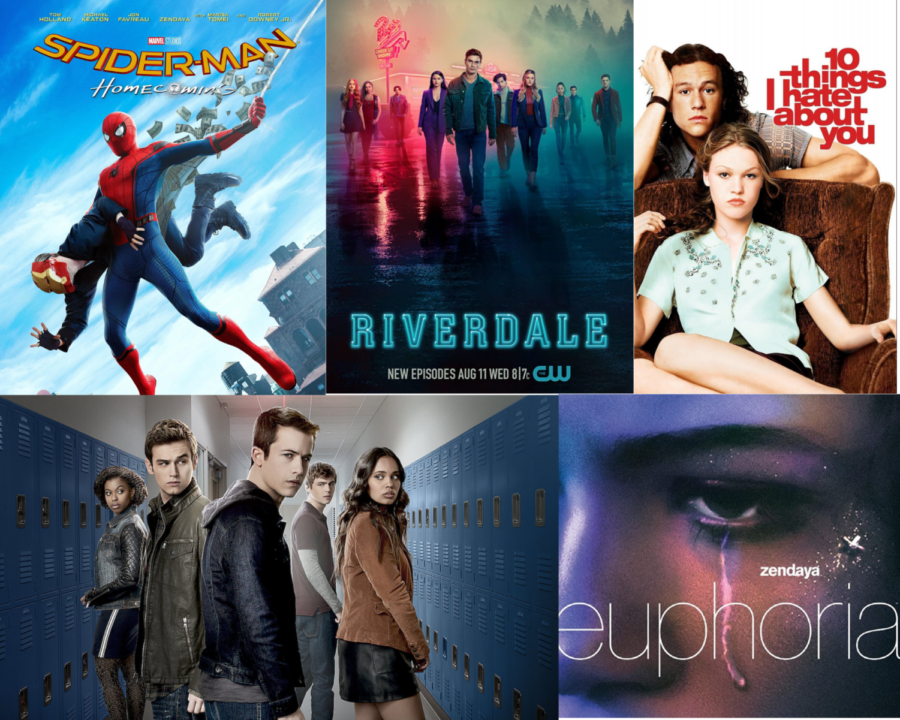Media is Harming Teens
Spiderman, Riverdale, 10 Things I Hate About You, Euphoria, and 13 Reasons Why (clockwise from top left) are just some examples of teen media. The characters depicted in these shows and movies are vastly different, due in part to the various ways producers choose to portray teenagers. (Graphic by Yasmin Roach)
A teenage girl walks into a dark room. She grabs a red solo cup filled with beer and joins dancers in the center of the room. The others at the party are drinking beer, too, some probably taking drugs.
This scene can be found in almost every mainstream movie or TV show about teens I can think of. And yet, most teens don’t have that experience, so it’s odd that the media portrays us that way.
Mainstream television and movie depictions of us are inaccurate, and they seem to be getting more and more so every year. This impacts how other people see us and even how we see ourselves.
An incredibly harmful depiction is the unrealistic way “13 Reasons Why” shows graphic self-harm and presents suicide. It makes it seem as though bullying could be the sole reason for someone’s suicide, rather than mental illness, or that suicide could be used as a sort of “revenge.”
A study done by the Journal of the American Academy of Child and Adolescent Psychiatry found a 28.9% increase in teen suicide a month after the first season of the show. This is a terrifying example of how serious of an impact fictional media can have on real life.
Teen bodies and lifestyles are also misrepresented in media. Most characters depicted in modern media don’t look or act like teenagers, which makes sense as lots of actors playing teens are adults.
They have adult bodies and adult faces, and their characters are put into adult situations. Having all the teens we see on-screen look nothing like us can make us feel that we are somehow inadequate because we still look and act like teenagers.
On top of that, there are many popular teen shows, such as the aforementioned “13 Reasons Why” or other shows like “Riverdale” and “Euphoria,” that normalize objectively harmful behavior, which makes it difficult for those with few other reference points to recognize the problems.
Almost every modern teen movie and television show I can think of has at least one scene where characters drink alcohol, take drugs, or have sex. But according to the CDC, only 38% of high schoolers reported having ever had sex in 2019, and alcohol and drug use are also down among them.
So when most of what we watch makes it seem like teenagers are wild party animals, it’s unfair to those of us that don’t live that life. It can make us feel like we’re missing out on some mythical “teen experience” that doesn’t actually exist.
Depictions seem to have changed with the time. When I watch older movies and shows, I find them to be more relatable than modern ones. For example, in the 1999 film “10 Things I Hate About You,” the characters are mainly pictured in school. This is realistic because teenagers spend most of their waking hours there.
When looking at shows made in the 2010s, it seems like the characters rarely even go to school. The average American teenager spends one-third of their day on school and homework, not to mention extracurricular obligations. Personally, I wouldn’t be able to find time to solve every murder mystery in town with three hours of free time every day.
I’m not suggesting that these shows and movies be exclusively doing homework. Instead, I want the creators to incorporate the reality of teenagers’ lives into the storyline, like in “10 Things I Hate About You” or the character Spiderman from the Marvel Cinematic Universe. Despite being played by an actor seven years older than him, Spiderman is purposely portrayed as much younger and has relatable conflicts with the school throughout the series.
Yes, teen shows and media are supposed to be fictional dramatizations of teen life, and that’s okay. The problem is when they aren’t showing the modern teen experience but rather something completely untrue. Fiction and reality do not exist separately. Reality inspires fiction, and fiction affects our view of reality, which is why fiction writers need to ensure that they are not presenting a distorted view of reality to the teenagers who watch their work.
When I walk around Wilde Lake, I don’t see students who look like 30-year-olds who have had plastic surgery. My classmates spend their nights doing homework, not going to raves. My friends who suffer from mental illness need help, not glamorization. But so much of what we see on-screen does not show that and harms us by not doing so.
Your donation will support the student journalists of Wilde Lake High School. Your contribution will allow us to purchase equipment and cover our annual website hosting costs.






